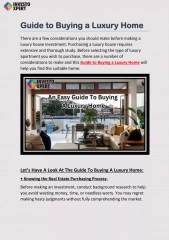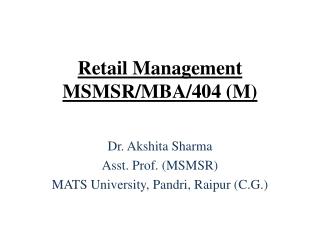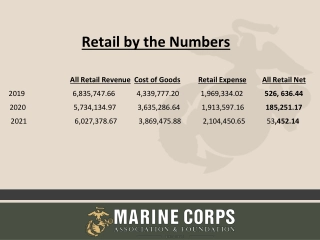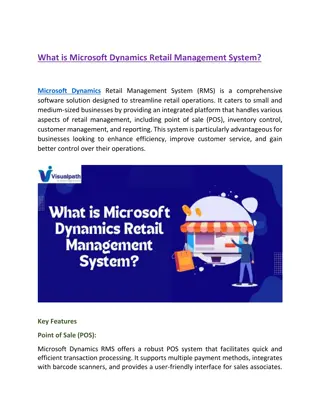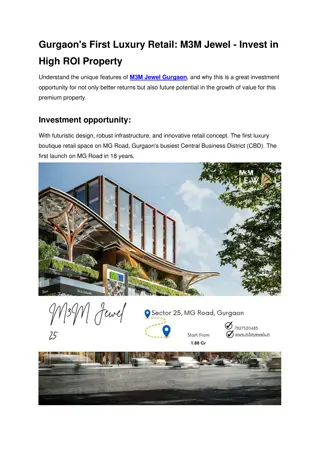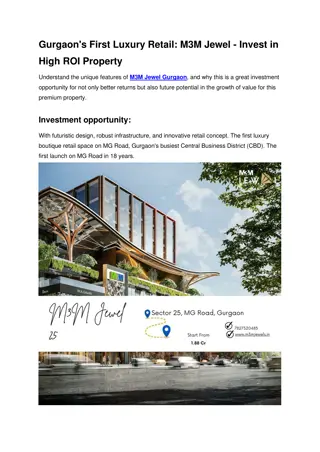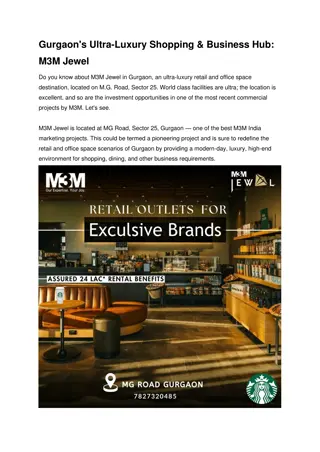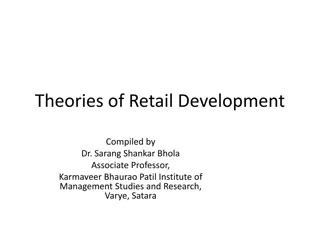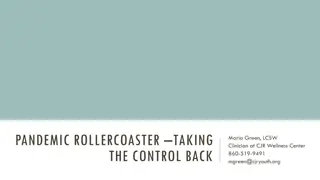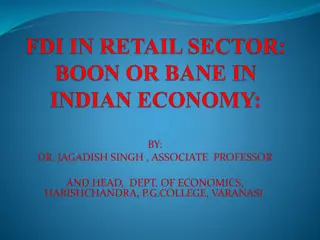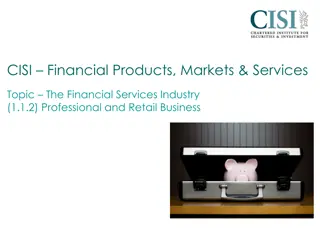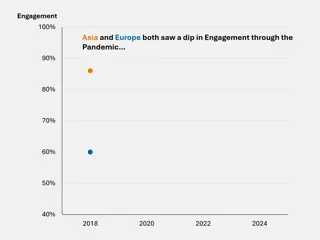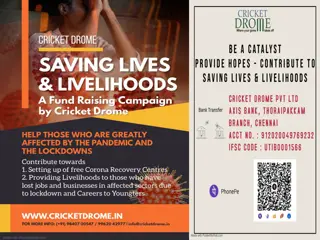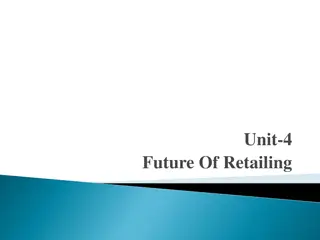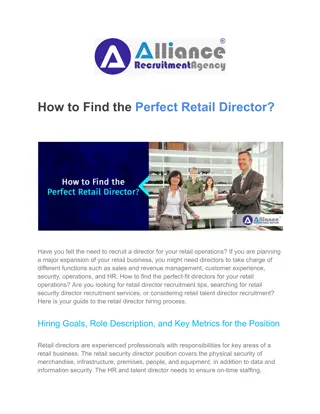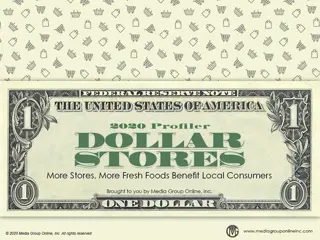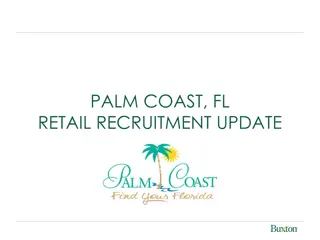Luxury Retail Trends Amid the Pandemic
Luxury retail industry executives are facing significant challenges due to the pandemic, with a majority postponing or canceling apparel orders from Asia-Pacific sources. However, there is a notable shift towards online luxury shopping, driven by wealthier individuals, particularly those with very high net worth. Affinity for luxury varies across regions, with Riyadh and Moscow showing high levels of interest. Despite uncertainties, there is a cautious optimism for the industry's long-term outlook.
Download Presentation

Please find below an Image/Link to download the presentation.
The content on the website is provided AS IS for your information and personal use only. It may not be sold, licensed, or shared on other websites without obtaining consent from the author.If you encounter any issues during the download, it is possible that the publisher has removed the file from their server.
You are allowed to download the files provided on this website for personal or commercial use, subject to the condition that they are used lawfully. All files are the property of their respective owners.
The content on the website is provided AS IS for your information and personal use only. It may not be sold, licensed, or shared on other websites without obtaining consent from the author.
E N D
Presentation Transcript
The Pandemic Hasnt Spared Luxury Retail Unsurprisingly, the largest percentage (54%) of the fashion industry executives responding to the April June survey for the United States Fashion Industry Association s 2020 Fashion Industry Benchmarketing Study said their biggest business challenge was the pandemic. The study also revealed all respondents (100%) said they are postponing or canceling apparel orders from their Asia-Pacific sources, and almost half anticipate postponed or canceled orders will continue during the second half of 2020, and 40% into 2021. The 57.9% of respondents who said they were optimistic/somewhat optimistic about the five- year outlook for the industry was the lowest ever, while the 31.5% who were pessimistic/somewhat pessimistic was the most since 2014.
Luxury Lives Online As with most retail sectors, luxury/fashion retail purchasing moved to the ecommerce channel with the coronavirus outbreak. According to data from Contentsquare, US online transaction for luxury products increased 45% during mid-April 2020. Even before the pandemic, almost half (47.5%) of all online fashion shoppers, responding to a Yotpo October 2019 survey said social media inspired their most recent fashion purchase, with 55.2% Gen Zers and 50.6% Millennials. Luxury retailer Fossil Group reported ecommerce sales accounted for almost 50% of all revenues during Q2 2020 (ending 7/4/20), compared to 13% for Q2 2019, while Tapestry s ecommerce sales during its Q4 fiscal year (ended 6/27/20) increased by triple digits.
Wealth Drives Luxury According to the Wealth-X Very-High-Net-Worth 2020 Handbook, very-high-net-worth (VHNW) individuals ($5 million $30 million) increased 10.2% globally during 2019 to 2.67 million while ultra-high-net-worth (UHNW) individuals ($30+ million) increased 25.5%. The US had the largest increase in VHNW, or 15.8%, and $9.50 trillion in total 2019 wealth. China was second with an 11.8% increase, but only totaled $2.59 trillion. Japan +11.3%, Germany +2.8% and France +10.2% were the remainder of the top 5 countries. The Wealth-X Global Luxury Outlook 2020 reported VHNWs and UHNWs continue to spend for luxury items, but the pandemic has limited their high-end travel and restaurant visits, resulting in an increase in luxury services at their homes.
Luxury Consumer Affinities The Wealth-X Global Luxury Outlook 2020 also calculated UHNW individuals affinity for luxury. Among those with $100+ million in net worth, individuals in Riyadh, Saudi Arabia had the highest level of affinity for luxury at 47.1%, with Moscow second at 28.4%. For those UHNW individuals with a net worth of $30 million $100 million, Moscow was first at 4.3% and Los Angeles second at 3.0%. Milan, Italy was first with a medium affinity for luxury at 50% for both those with $100 million+ and $30 million $100 million in net worth. The US, Canada and Mexico were the top three countries for UHNW private-jet owners during 2019. Unsurprisingly, 92.2% were men, 52.7% of all of them were 50 70 years of age and 38.5% 70 years of age or older.
Luxury Shopper Insights According to a June 2020 survey from Provoke Insights, 66% of consumers said they planned to shop at luxury retailers; however, 42% said they would shop less, 45% shop approximately the same and 12% shop more. The youngest luxury shoppers are the prime targets for retailers and, according to the survey, 49% of Gen Zers and 38% of Millennials said they would like to schedule a personalized appointment at luxury retailers to avoid other shoppers. Among the Millennials surveyed, 18% said they were more likely to purchase 10% much more/slightly more for fine jewelry and watches and 17% were likely to purchase 9% much more/slightly more for handbags and accessories.
Waiting for Weddings With only 1.11 million weddings planned for 2020, compared to 2.13 million during 2019, much of the $3.50 billion spent during 2019 to purchase or rent bridal-party dresses and formal wear for the groom, groomsmen and fathers has been in jeopardy. According to The Wedding Report, 41.5% of couples moved their wedding date to 2021 and 46% of couples said they will reduce their budget by an average of 31%. The Wedding Report forecasts 650,000 more weddings during 2021, to a total of 2.77 million. The significant decline in 2020 weddings came at the worst time for Tailored Brands (Men s Wearhouse, Jos. A. Bank, Moores Clothing for Men and K&G), which filed for bankruptcy during August 2020 and plans to close 500 of its approximately 1,300 stores.
Advertising Strategies Luxury retail consumers are not much different from all other consumers: They are attracted to bargains/discounts for both every-day and luxury items, so specials should be emphasized during major holiday season promotions. Luxury retailers, like most others, must promote/require mask-wearing, social distancing and other health protocols to attract their target audience, but they may want to initiate and promote personalized appointments, so customers feel even safer. According to The Media Audit data on page 4 of the Profiler, there are various correlations of the daily media use of adults 18 44 and their readership of print or digital newspapers fashion section, thus providing a unique, combo ad media buy to reach this audience.
New Media Strategies Because social media inspires most fashion shoppers purchases, luxury retailers (and those selling luxury merchandise) must utilize this channel, with fashion shows (YouTube), catalogs (Pinterest) and promotions for special luxury apparel/accessory bundles. Ask customers and other social media visitors to share (in short videos) how they ve adapted their fashion apparel and style to still enjoy them although they are spending more time at home and less (or no time) time at parties, events, etc. Opera and symphony patrons and attendees are also luxury consumers. With most of those events cancelled, some organizations are trying to perform online, providing luxury retailers with unique sponsorship/advertising opportunities.


